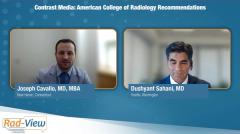
Imaging Modalities in Medical Diagnosis and Treatment
Joseph Cavallo, MD, MBA, and Dushyant Sahani, MD, provide a brief overview of imaging modalities and their importance in medical diagnosis and treatment.
Joseph Cavallo, MD, MBA: Hello, everyone. Thank you for joining us today. This is Diagnostic Imaging Rad ViewTM program, titled “Radiologist’s View Into the Role of Generic Contrast Agents in Imaging Modalities.” My name is Dr Joseph Cavallo, and I’m an assistant professor of radiology and biomedical imaging at the Yale School of Medicine. Joining me today is Dr Dushyant Sahani, a professor and chair of radiology at the University of Washington. Thank you for joining me, Dr Sahani. Let’s get started.
Dushyant Sahani, MD: It’s my pleasure, Dr Cavallo.
Joseph Cavallo, MD, MBA: Great to have you. Just so we have a good baseline for anybody joining the discussion here, [let’s] start with some of the basics. You can introduce some of the various imaging modalities we’re going to be talking about today, [as well as] their importance as it relates to prompt diagnosis and treatment.
Dushyant Sahani, MD: That’s a foundational question, when we look at imaging modalities in the field of radiology. Today…health care has been fundamentally transformed due to advances in imaging techniques. These are not [only] relevant to giving an accurate and reliable diagnosis, but imaging is also being applied for treatment selection, decision-making, monitoring effectiveness of therapies, and prognosticating patients. A lot of research and education is also being influenced by all the advances we have made in imaging technologies, and the field looks so promising as we add computation and some of the new molecularly targeted therapies. The impact of imaging and its value continues to go up.
Joseph Cavallo, MD, MBA: Yeah, I agree. It’s a really exciting time to be in the field of radiology, and it’s one of the reasons I went into this field to begin with. Getting a little more specific, could you give some brief comments on specific types of imaging modalities, specifically computed tomography [CT] scans and magnetic resonance imagings [MRIs], [as well as] some of the specific importance of each of those modalities?
Dushyant Sahani, MD: That’s a really great question. If we look at health care today, and you look at many important specialties, you realize that imaging is a gateway to care delivery. There are no major decisions being made without availability of imaging. CT has made a big impact to the progress of health care…. Certain medical specialties’ progress wouldn’t have been possible without availability of accurate, safe, and reliable imaging techniques readily available at the site of care delivery. Take acute care, for example. The whole patient triage and interventions is heavily based on imaging. I would say close to 70% of patients who come through the [emergency department] get some form of imaging. That shows you how much our referring physicians trust these imaging modalities to make the critical decision-making that has to be timely [and] more actionable for the specific task at hand. If you look at other specialties [such as] cardiovascular imaging, the whole field hinges around progress we have made on diagnostic imaging that has influenced therapies. A lot of oncologic innovations have happened because we have very high-quality imaging—whether it’s MRI, CT scan, some molecular imaging techniques [such as] positron emission tomography CTs—and the same trend continues now on the therapeutic side. Image-guided therapies rely heavily on the diagnostic imaging techniques that are available to help tailor treatment [and] precisely deliver those therapies, causing minimal impact to adjust a normal tissue and having more effective outcomes in these patients. In summary, imaging techniques like CT and MRI, but also other advanced imaging, has made a big impact to care delivery, research, innovation, and discoveries. They are also so fundamental to how modern medicine is practiced today.
Joseph Cavallo, MD, MBA: As an emergency radiologist myself, I can vouch for your statement regarding the ubiquity of specifically CT imaging on the patient care experience in the emergency department. Seems like just about everybody is needing some advanced imaging at this point, and it really helps us get the correct diagnosis from the start.
Dushyant Sahani, MD: Not only that, [but] if you look at how we are training the next generation of physicians and specialists, their training is heavily influenced by familiarity to not only what exams they order but [also] the value of these imaging techniques. Take…for example, neurology. The whole field—whether it’s stroke, tumor, or cognitive impairment—involves advanced imaging techniques. And imaging is not solely responsible for those decisions, but [it] is a major component where you integrate other information [such as] lab clinical imaging, then come up with more comprehensive or more holistic type of treatment delivery for these patients. It’s fascinating time…the progress in imaging and how it’s translating into success stories for patients on a daily basis. I feel so privileged to be part of that journey.
Transcript is AI-generated and edited for clarity and readability.
Newsletter
Stay at the forefront of radiology with the Diagnostic Imaging newsletter, delivering the latest news, clinical insights, and imaging advancements for today’s radiologists.


































